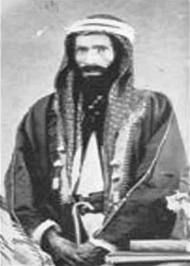Muhammad Ibn Abd al-Wahhab (Saudi Arabia)
- Chad Moore
- Feb 21, 2016
- 3 min read


Muhammad Ibn Abd al-Wahhab, father of the Wahhabi Movement within Sunni Islam, was born 1703 in al-Uyayna in Najd (located in what is now central Saudi Arabia). At his birth, Arabia functioned under the authority of the Ottoman Empire. His family consisted of many highly qualified and respected theologians and jurist, all belonging to the Hanbali School of Thought. As Ibn Wahhab grew and received a strong and privileged education, the religious and social fragmentation and deviation (what he deemed as polytheistic in nature) from what he considered orthodox Islam inspired Ibn Wahhab’s revivalist ideas and beliefs. He viewed the state of Islam as having swayed away from what the Prophet Muhammad spoke of and what Allah truly desired for the Muslim people. He promoted ideas of purification, removing all innovation of faith and practice and replacing them with “true Islam”— Islam without human veneration, invention, or innovation of any variety—an Islam of truly monotheistic faith and based only on the Shari’ah. Such beliefs were not widely accepted by the Muslim population of the time.
In 1726, due the Muhammad Ibn Abd al-Wahhab’s unconventional and unpopular theological conclusions, he was forced to leave al-Uyayna with this family and resettle in Hejaz (in the west of modern day Saudi Arabia). While living in Hejaz, Ibn Wahhab continued his studies of Islamic tradition under Shaykh Abd Allah Ibn Ibrahim Ibn Sayf and Shaykh Hayat al-Sindi. Additionally, after making hajj to Mecca and Medina, he visited Basra (located in modern day Iraq on the Shatt al-Arab River) where he witnessed the veneration of Ali’s shrine and the burial location of Hussein—extremely celebrated historical and religious figures of the Shiite sect—which furthered his commitment of eradicating such practices, practices that he viewed a polytheistic and blasphemous, from Islam. This led him to write Kitab al-Tawhid (Book of Monotheism) criticizing such practices and publicizing his reformist/revivalist positions. His position was strongly opposed by members of his own family and the ulama of al-Uyayna.
His ideas were met with such opposition that, in the 1740’s, Muhammad Ibn Abd al-Wahhab formed an alliance—an alliance of questionable foundation—with Uthman Ibn Mu’ammar, the leader of al-Uyayna (Ibn Wahhab’s birth place). The alliance gave protection to Ibn Wahhab and Ibn Mu’ammar ordered the citizens of his domain to observe the practices and beliefs formulated by Ibn Wahhab. By implementing Wahhabi Doctrine onto the community, the ulama was challenged and increased attacks on the doctrine. This led to a standoff between the ulama of al-Uyayna and Ibn Wahhab, the ulama attacking the removal of veneration and the reinstating of punishment such as stoning, while Ibn Wahhab called into question the legitimacy of the ulama due to their opposition to the “true Islam.” Ibn Wahhab called for total war against those that did not follow the strict guides of Wahhabism. In response to the turmoil caused by the movement, Banu Khalid tribal leader Sulayman Ibn Muhammad called for Uthman Ibn Mu’ammar to retract protection and exile or execute Ibn Wahhab. The al-Uyayna leader selected exile.
After exile from al-Uyayna, Muhammad Ibn Abd al-Wahhab created another alliance—an alliance that would prove most successful for Ibn Wahhab—with the enemy of Sulayman Ibn Muhammad, Muhammad Ibn Saud (the founder of the House of Saud) in Dar’iya (on the north-western outskirts of Riyadh, the capital of modern day Saudi Arabia). The alliance between Ibn Wahhab and Ibn Saud was the start of the long lasting relationship between Wahhabism and Saudi Arabia. In the areas surrounding Dar’iya, Wahhabism was already widely accepted and gave political and military power to Ibn Saud through the support of local groups against his enemies. In 1746, under the belief that those against Wahhabism were enemies to Islam and must be destroyed and conquered, Ibn Saud led forces to dominate that region. In 1773, Riyadh fell to Ibn Saud’s forces and started the first of three period of rule by the House of Saud. The arrangement stated that Ibn Saud would control the political and military elements of Saudi Araba and Ibn Wahhab would control the religious elements.
Muhammad Ibn Abd al-Wahhab died in 1792.

Written By: Chad Moore
References
Al-Yassini, Ayman. Religion and State in the Kingdom of Saudi Arabia. Boulder: Westview, 1985. Print.
Ayoob, Mohammed, and Hasan Kosebalaban. Religion and Politics in Saudi Arabia: Wahhabism and the State. Boulder: Lynne Rienner, 2009. Print.
Commins, David. Islam in Saudi Arabia. New York: Cornell UP, 2015. Print.
Opmerkingen